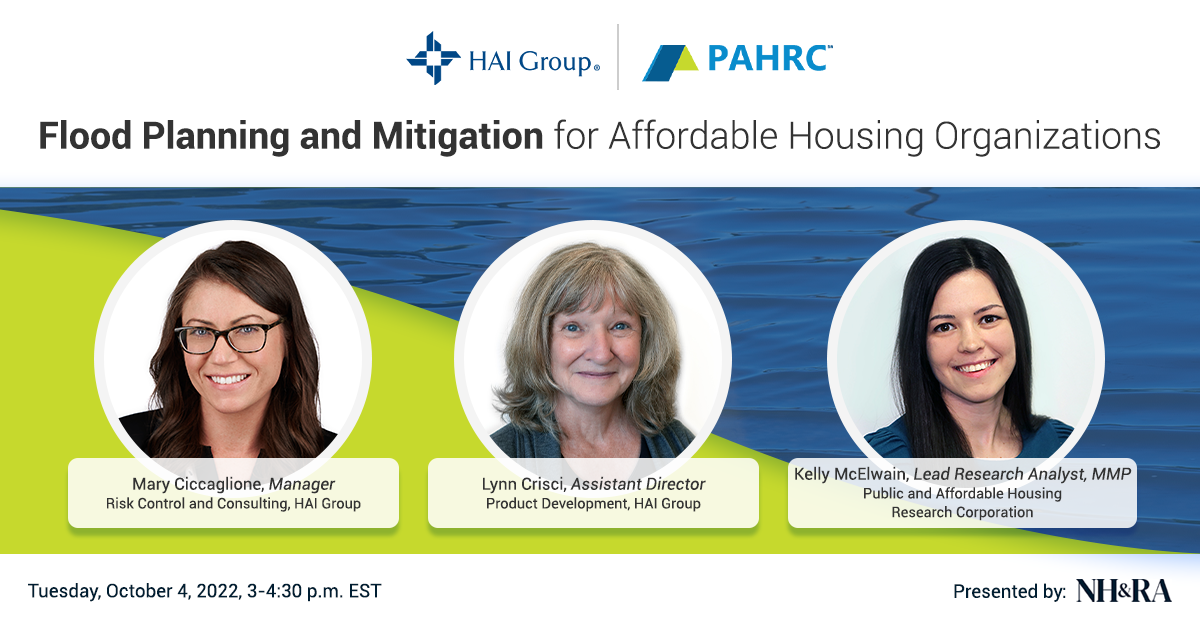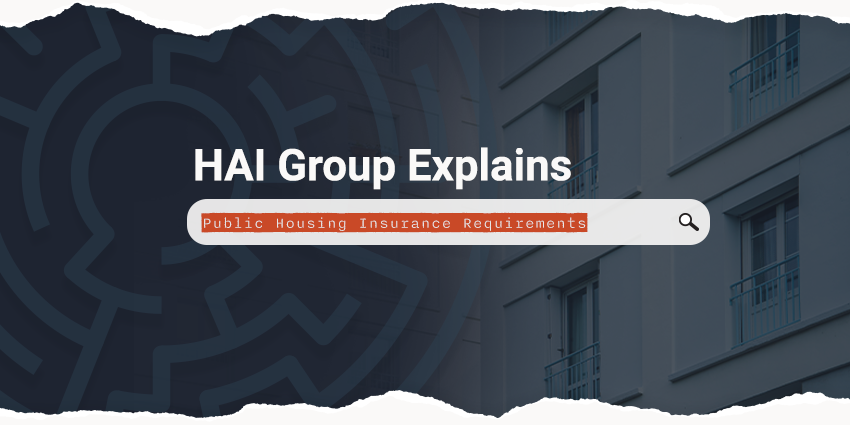With flooding now the top natural peril in the U.S., and research finding that 40 percent of the nation’s occupied rental stock is located in areas likely to experience a substantial annual loss due to natural disasters, one thing’s for sure: It is critical for affordable housing providers to be prepared. On the heels of their recent webinar, titled Flood Planning and Mitigation for Affordable Housing Organizations, the Public and Affordable Housing Research Corporation’s Lead Research Analyst Kelly McElwain, and HAI Group’s Lynn Crisci, assistant director of Product Development, along with Mary Ciccaglione, manager of Risk Control and Consulting, spoke with HAI Group’s Staci Canny to answer some of the webinar audiences’ top questions.
 Staci Canny: Thank you all for taking a moment to discuss this timely topic. Your webinar detailed the National Flood Insurance Program’s (NFIP) new rating methodology, Risk Rating 2.0, which is transforming the flood insurance industry. Can you summarize what this entails?
Staci Canny: Thank you all for taking a moment to discuss this timely topic. Your webinar detailed the National Flood Insurance Program’s (NFIP) new rating methodology, Risk Rating 2.0, which is transforming the flood insurance industry. Can you summarize what this entails?
Lynn Crisci: Sure. Risk Rating 2.0 was rolled out nationwide in October 2021 for new policies, and renewal policies began to convert in April 2022. Unlike the NFIP’s previous methodology, which priced policies based on the flood zone and the elevation of the building, this version uses a site-by-site approach, determining flood susceptibility at an address-level. This means that premiums will be priced based on several characteristics that impact flood risk, such as the construction materials used, how the building was constructed, and the cost to rebuild, in addition to other flood risk characteristics, such as distance to flood sources. These changes allow FEMA to provide actuarially sound rates. I encourage everybody to visit FEMA’s website to access educational materials about these program changes.
SC: One of the most notable aspects of Risk Rating 2.0 is the ‘four or more flood event rule.’ Can you explain what this means?
LC: Under this current plan, if you present a claim to the NFIP and they realize they have already paid for four or more flood events at that location, regardless of whether or not you owned that property during those claims, the NFIP will not renew or offer you coverage.
SC: Wow, that can be devastating news. So, if a property owner finds themselves in a situation with trouble getting flood insurance, what should they do?
LC: They’re probably going to have to look to the residual markets—the excess and surplus lines—and see if insurance is available outside the NFIP.
Kelly McElwain: If you own a property that has experienced multiple floods, there are some FEMA and HUD programs that provide funding to state and local governments, which can be used to buy out a property in a high-risk area and replace it with a property in a lower-risk area. You can learn more about property buy-out programs here.
SC: Do property owners typically know what they’re getting into when they acquire a new property, such as whether it’s located in a flood zone or has experienced flood claims?
LC: Several states have a law known as flood disclosure, and that means that usually, at the time of closing, you’re given a one-pager that says oh, by the way, you’re in a flood zone. At this point, it’s too late to back out of the transaction. That may change. FEMA and the NFIP are putting pressure on the real estate industry to move flood disclosures up—at the point of property presentation rather than at the closing. But this would cause a significant shift in the marketplace because it would essentially disincentivize people from purchasing those properties. (If you’re interested in learning more about how to request a property’s flood loss history, download this resource.)
KM: Another thing to note is that flood disclosure laws vary by state. Some states have stringent laws that require the owner to disclose whether the property has experienced a flood, while others have laws but minimal penalties, making it not worthwhile to disclose this information. Some don’t have any requirements. If you’re considering purchasing a new site, check out the Natural Resources Defense Council’s flood disclosure map, which outlines flood disclosure laws by state.
SC: So, if an agency decides to build on a new site, what are some things to consider prior to construction that will make a building more resilient to flood?
Mary Ciccaglione: Take a look at the critical infrastructure in the area that the site will be dependent upon, like bridges and power stations, and how they would be impacted by flood risk. Also, remember it’s almost always more expensive to bring a building up to code after it’s already built, so even if your jurisdiction hasn’t adopted the most up-to-date codes, it’s a good idea to construct to modern codes. Make sure the lowest occupied floor is above the base flood elevation, ensure adequate site drainage, and consider barriers that will protect the site.

SC: If a property owner takes the initiative to deploy flood mitigation measures to a building in a floodplain that has had flood events in the past, will this resolve that building’s insurable status?
LC: It depends. Of course, you want to reduce the exposure or risk of damage to your properties from flooding. But, regarding how this can impact your building’s insurable status, I suggest property owners talk to their NFIP agent about that. With this Risk Rating 2.0 playing out in real-time, we’ll see what happens with Hurricane Ian and the rest of the year, and if there is a lot of pushback from constituents, we may see some softening of rules.
SC: Speaking of mitigation, building codes are another measure to help reduce property damage. However, knowing that there is a wide range of adoption and enforcement with these codes, as they fall into the laps of local jurisdictions, are insurance companies offering premium savings for policyholders who have buildings complying with stricter building codes?
LC: It depends on the insurance company. Most recently, three states—Alabama, South Carolina, and Mississippi—have passed legislation for residential buildings. If they incorporate wind or water mitigation, insurance companies are required to recognize that with credits. For other insurance carriers, you need to look at their plans to see if they’re willing to go beyond what state legislation requires.
SC: Before we wrap up, are there any federal programs you recommend that housing agencies look into to help with their flood mitigation efforts?
KM: There are so many programs out there, but some notable ones that I recommend include FEMA’s Hazard Mitigation Grant Program, Building Resilient Infrastructure and Communities (BRIC) program, and Flood Mitigation Assistance (FMA) grant programs, as well as HUD’s Community Development Block Grant-Disaster Recovery (CDBG-DR) and CDBG Mitigation (CDBG-MIT) programs. And another resource to use is this guide, Ready to Respond: Strategies for Multifamily Building Resilience, offering strategies to make multifamily buildings resilient to severe weather.
SC: Thank you, Lynn, Kelly, and Mary, for this valuable information.

Missed the webinar? You can watch it on demand here: Flood Planning and Mitigation for Affordable Housing Organizations. For more information on flooding, check out PAHRC and the National Low Income Housing Coalition’s report, Taking Stock: Natural Hazards and Federally Assisted Housing.
Includes copyrighted material from a company under the HAI Group family, with its permission. This post is for informational purposes only and is not intended to provide legal advice, and shall not be relied on as such. We strongly recommend consulting with legal counsel or an appropriate subject matter expert.






